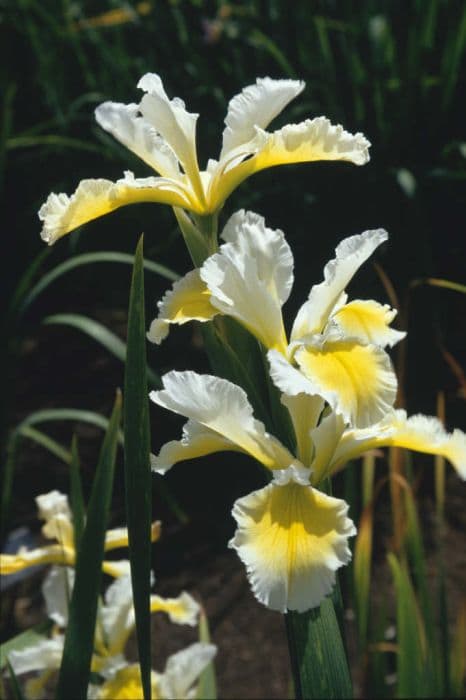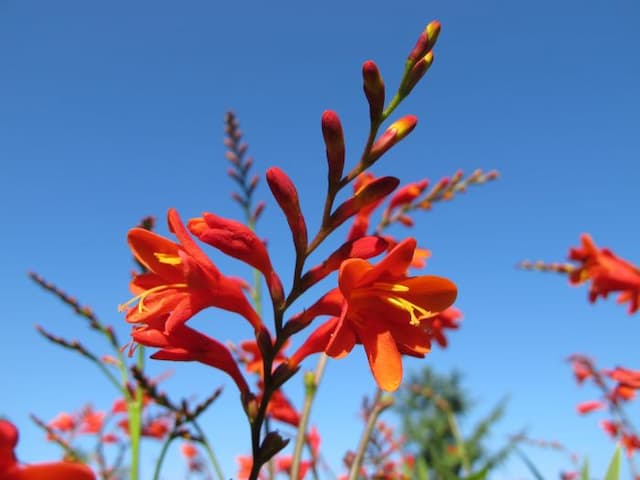Spuria Iris Iris 'Ila Crawford' (Spuria)

ABOUT
Iris 'Ila Crawford' is a striking perennial plant known for its vibrant flower display and foliage. The plant showcases flowers that display a beautiful blend of colors, usually featuring a prominent, rich yellow hue with contrasting purplish-brown veining, giving it a dramatic and eye-catching appearance. The blooms are large and ornamental, composed of three upright petals known as standards and three downward-curving petals known as falls. This combination creates a unique and graceful form that is characteristic of the iris family. The foliage of Iris 'Ila Crawford' consists of long, slender, sword-like leaves that are a bright green color. These leaves elegantly fan out from the base of the plant, creating an attractive backdrop for the stunning flowers that emerge on sturdy stalks. The overall visual effect of the plant is one of classic beauty and refinement, making it a noteworthy addition to any garden setting known for attracting viewers and pollinators alike.
About this plant
 Names
NamesFamily
Iridaceae
Synonyms
Spuria Iris, Butterfly Iris, Ila Crawford Iris
Common names
Iris 'Ila Crawford'
 Toxicity
ToxicityTo humans
The Iris 'Ila Crawford', more commonly referred to simply as an Iris, is known for many types that can be toxic to humans if ingested. The rhizomes and bulbs of Irises contain irritating substances that can lead to gastrointestinal discomfort. Symptoms of Iris poisoning may include nausea, vomiting, abdominal pain, and diarrhea. In some cases, this can also lead to skin irritation when handled. It is advisable to avoid ingesting any part of the Iris plant and to handle it with care if pruning or planting.
To pets
The Iris 'Ila Crawford', commonly referred to as an Iris, may be toxic to pets if ingested. The rhizomes and bulbs of the plant contain compounds that are particularly irritating and can cause digestive upset in animals. Symptoms of Iris poisoning in pets can include drooling, vomiting, diarrhea, and abdominal pain. In severe cases, ingestion could result in lethargy or a more serious gastrointestinal disturbance. Pet owners should prevent their animals from consuming any part of an Iris plant and seek veterinary attention if ingestion is suspected.
 Characteristics
CharacteristicsLife cycle
Perennials
Foliage type
Deciduous
Color of leaves
Green
Flower color
Mixed
Height
3-4 feet (0.9-1.2 meters)
Spread
1-2 feet (0.3-0.6 meters)
Plant type
Bulb
Hardiness zones
5
Native area
Cultivar
Benefits
 General Benefits
General Benefits- Landscape Beautification: The Iris 'Ila Crawford' adds aesthetic value to gardens with its striking blooms and tall, elegant stature.
- Low Maintenance: This type of iris is relatively low maintenance, once established, requiring minimal care.
- Drought Tolerance: Spuria irises, like 'Ila Crawford', are more drought-tolerant than many other iris types, making them suitable for xeriscaping.
- Pollinator Attraction: The flowers attract bees, butterflies, and other beneficial insects, supporting local ecosystems.
- Seasonal Interest: With its late spring to early summer blooming period, it provides interest during a time when many other plants may not be in flower.
- Deer Resistance: This iris is generally resistant to browsing by deer, making it a good choice for gardens in areas with deer populations.
- Versatile Use: It can be used in a variety of garden settings, including borders, beds, and as a focal point.
- Cut Flowers: The blooms make excellent cut flowers, allowing for indoor enjoyment of their beauty.
- Naturalizing: Iris 'Ila Crawford' can naturalize in suitable conditions, gradually forming larger clumps and increased floral displays.
 Medical Properties
Medical PropertiesThis plant is not used for medical purposes.
 Air-purifying Qualities
Air-purifying QualitiesThis plant is not specifically known for air purifying qualities.
 Other Uses
Other Uses- Decorative Dried Arrangements: The tall, elegant stems and seedpods of the Spuria Iris can be dried and used in floral arrangements for long-lasting decoration.
- Artistic Inspiration: The unique color and form of Spuria Iris flowers can inspire artists and be used as subjects in paintings, drawings, and photography.
- Eco-friendly Dye: The petals of Spuria Iris can be used to produce natural dyes for fabrics, offering an environmentally friendly alternative to synthetic dyes.
- Garden Design: Due to their distinctive height and form, Spuria Irises can be used as structural elements in garden design, providing vertical interest.
- Photography Backdrops: The lush foliage and striking flowers of the Spuria Iris can serve as a natural backdrop for outdoor portrait photography.
- Educational Tool: The distinct morphology of Spuria Iris can be used in educational settings to teach students about plant anatomy and pollination mechanisms.
- Culinary Garnish: The petals of Spuria Iris, while not commonly used, can occasionally garnish desserts or salads after proper identification and ensuring they are free from pesticides.
- Perfumery: The scent of some Spuria Iris varieties may be used in the creation of perfumes, offering a unique floral note.
- Craft Projects: Dried Spuria Iris flowers and leaves can be incorporated into various craft projects, including handmade paper or potpourri.
- Water Conservation: Being drought-tolerant, Spuria Iris can be used in xeriscaping to create beautiful landscapes that require less water.
Interesting Facts
 Feng Shui
Feng ShuiThe Iris is not used in Feng Shui practice.
 Zodiac Sign Compitability
Zodiac Sign CompitabilityThe Iris is not used in astrology practice.
 Plant Symbolism
Plant Symbolism- Faith: The Iris is often associated with faith and wisdom. This symbolism dates back to ancient Greek times when the goddess Iris, who the flower is named after, was considered the messenger of the gods and a link between heaven and earth.
- Hope: The iris conveys a message of hope, indicating that one should remain hopeful even through difficult times.
- Courage: In some cultural contexts, the iris represents courage and admiration. It's often used to convey a sense of bravery and to honor someone's bold actions.
- Royalty: Due to its regal appearance and history, the iris often symbolizes royalty and noble bearing. Its presence in royal emblems and crests emphasizes this association.
 Water
WaterThe Spuria Iris, including the 'Ila Crawford' variety, prefers consistent moisture but does not like to be waterlogged. Water these Irises deeply every week, providing about one inch of water which equates to approximately 0.6 gallons per square yard. During hot or dry spells, increase watering to twice per week, ensuring the soil is well-drained to prevent root rot. Reduce watering after the blooming period as the foliage begins to die back in preparation for their dormant season.
 Light
LightSpuria Iris thrives best in full sunlight, meaning it should receive at least six hours of direct sunlight each day. The ideal spot for planting 'Ila Crawford' would be an area that is sunny from morning to mid-afternoon, with some shade in the hottest part of the day if you live in a particularly hot climate, to prevent leaf scorch.
 Temperature
TemperatureThe Spuria Iris 'Ila Crawford' can survive a range of temperatures but blooms best when the nighttime temperatures are between 50 and 60 degrees Fahrenheit and daytime temperatures are between 70 and 80 degrees Fahrenheit. They are hardy to USDA zones 4 through 9, which means they can withstand minimum winter temperatures down to -30 to -20 degrees Fahrenheit.
 Pruning
PruningPrune Spuria Iris 'Ila Crawford' after blooming by removing spent flower stalks to tidy up the plant and encourage next year's blooms. Cut foliage to the ground in late fall after it has yellowed and died back to prevent overwintering pests and diseases. Pruning is typically done once annually after the blooming season ends.
 Cleaning
CleaningAs needed
 Soil
SoilSpuria Iris 'Ila Crawford' thrives in well-draining soil with a neutral to slightly alkaline pH, ideally between 6.5 to 8. Amend the soil with plenty of organic matter and ensure it is loose and fertile for optimum growth.
 Repotting
RepottingSpuria Iris 'Ila Crawford' should be repotted every 3 to 4 years to prevent overcrowding and to refresh the soil, as they tend to form large clumps and can become less vigorous without division.
 Humidity & Misting
Humidity & MistingSpuria Iris 'Ila Crawford' is tolerant of a wide range of humidity levels and does not require high humidity to thrive; normal outdoor conditions are usually sufficient.
 Suitable locations
Suitable locationsIndoor
Place Spuria Iris in a sunny spot with good airflow.
Outdoor
Plant in full sun with well-draining soil.
Hardiness zone
4-9 USDA
 Life cycle
Life cycleThe Spuria Iris 'Ila Crawford' begins its life cycle as a seed, which, when sown, will germinate given adequate moisture and temperature conditions. The seedling emerges and develops into a young plant with a strong root system and distinctive foliage. Over time, the plant reaches maturity, forming robust clumps of strap-like leaves and tall, sturdy stems. The mature Spuria Iris then blooms in late spring to early summer, producing large, intricate flowers that exhibit various blends of colors, typically in warm tones. After the flowering period, the plant sets seed, which can be collected for propagation or left to self-sow. In preparation for winter, the plant enters dormancy, during which the foliage may eventually die back, and the plant conserves energy in its rhizomes, ready to regrow the following spring.
 Propogation
PropogationPropogation time
Late Summer to Early Fall
The best time to propagate the Iris 'Ila Crawford', also known as Spuria Iris, is in late summer after the plant has bloomed and begun to go dormant. Division of the rhizomes is the most popular method for propagating this type of iris. To propagate by division, carefully dig up the clump of rhizomes once the foliage has begun to die back. Using a sharp knife, separate the rhizomes, ensuring that each division has at least one fan of leaves and a portion of the roots. Trim the leaves to about a third of their height to reduce water loss and replant the divisions at the same depth they were growing before, spacing them about 12 to 24 inches apart. Water the new plantings well to help establish them. It's important for the divisions to have some time to establish before the onset of winter, which is why late summer is the ideal time for this process.








![Montbretia [Little Redhead]](/_next/image?url=https%3A%2F%2Fplants-admin.emdemapps.com%2Fimages%2Fplants%2F%2Fimages%2F604b5635373f8.png&w=640&q=75)
